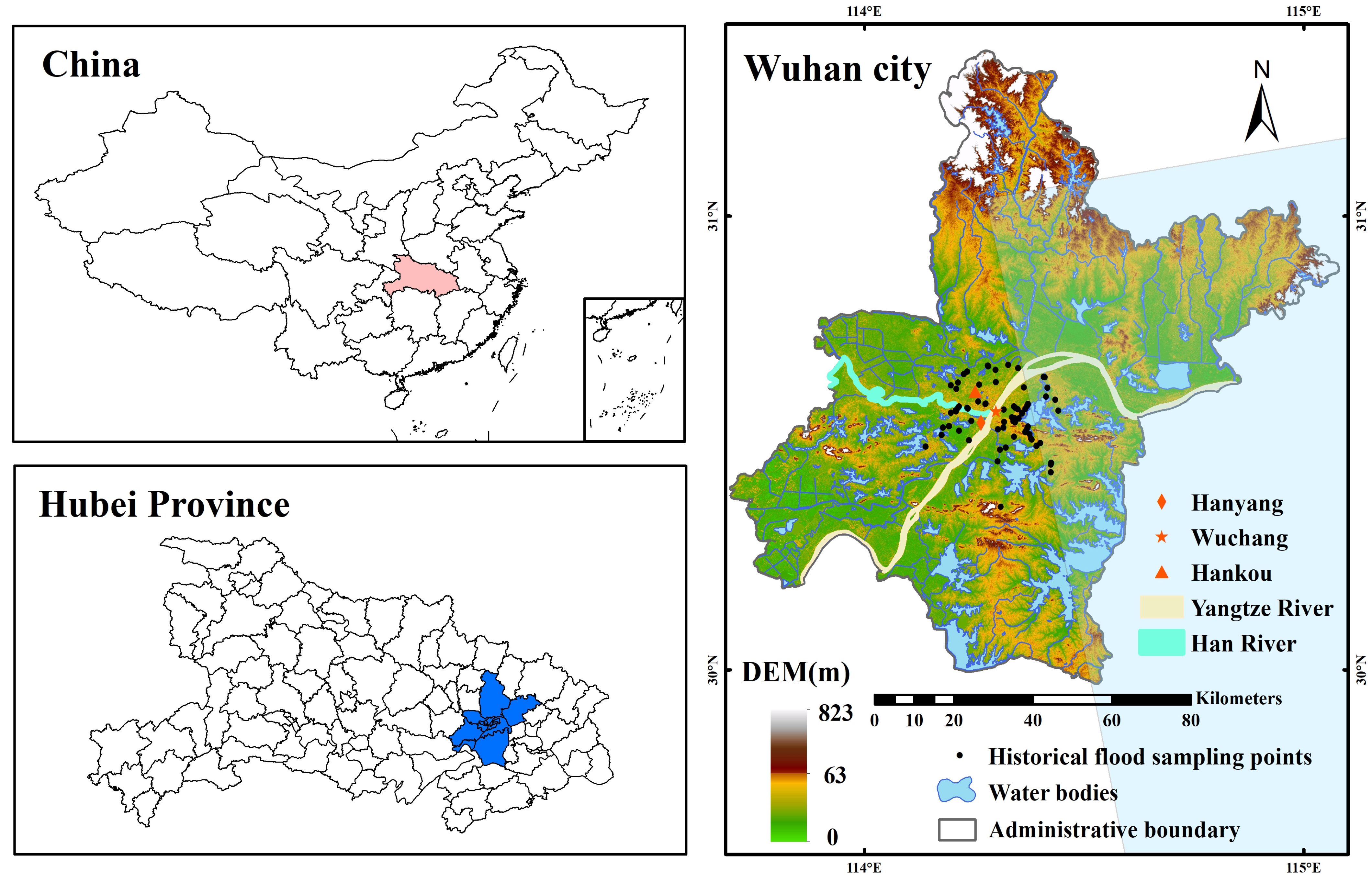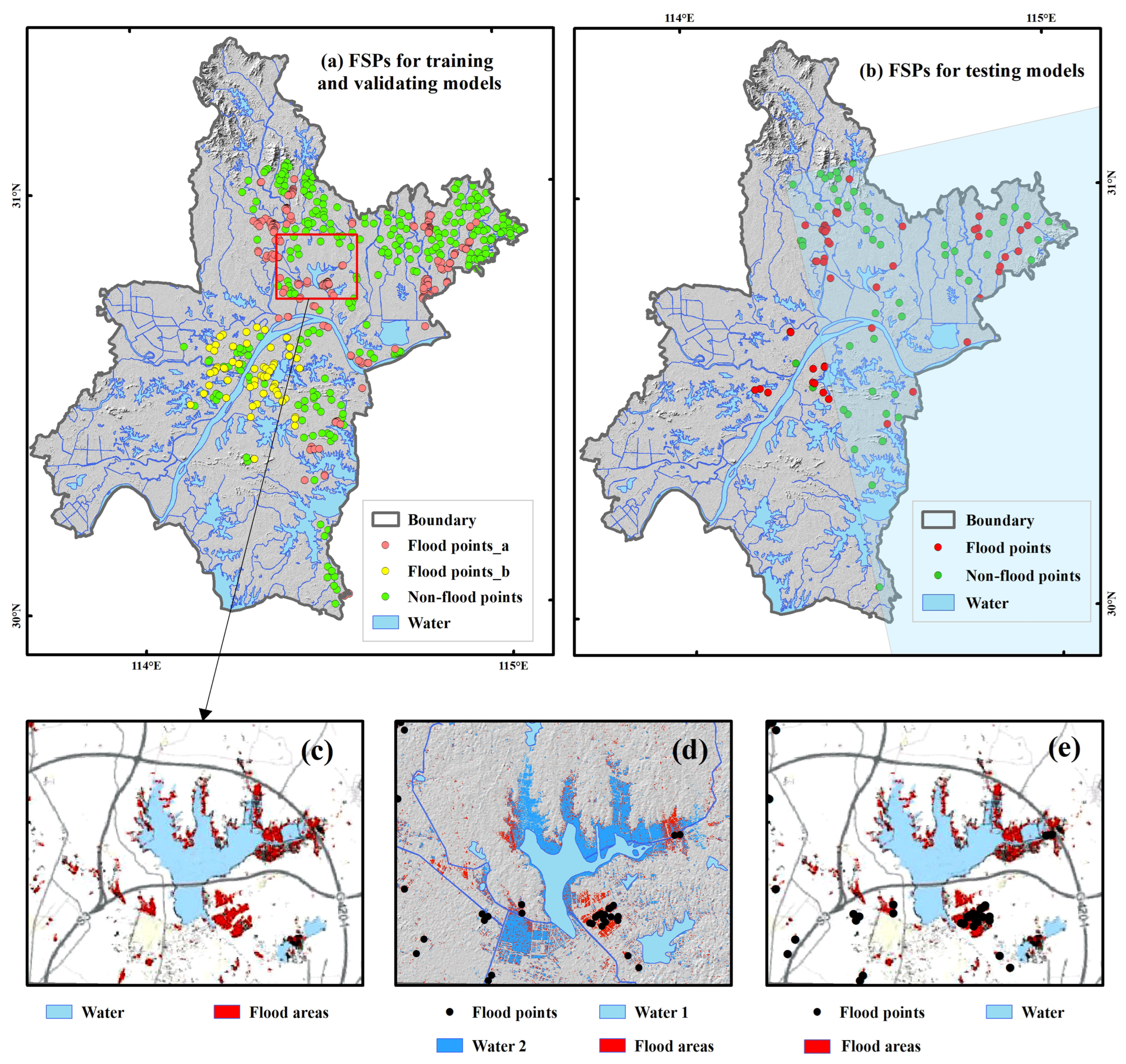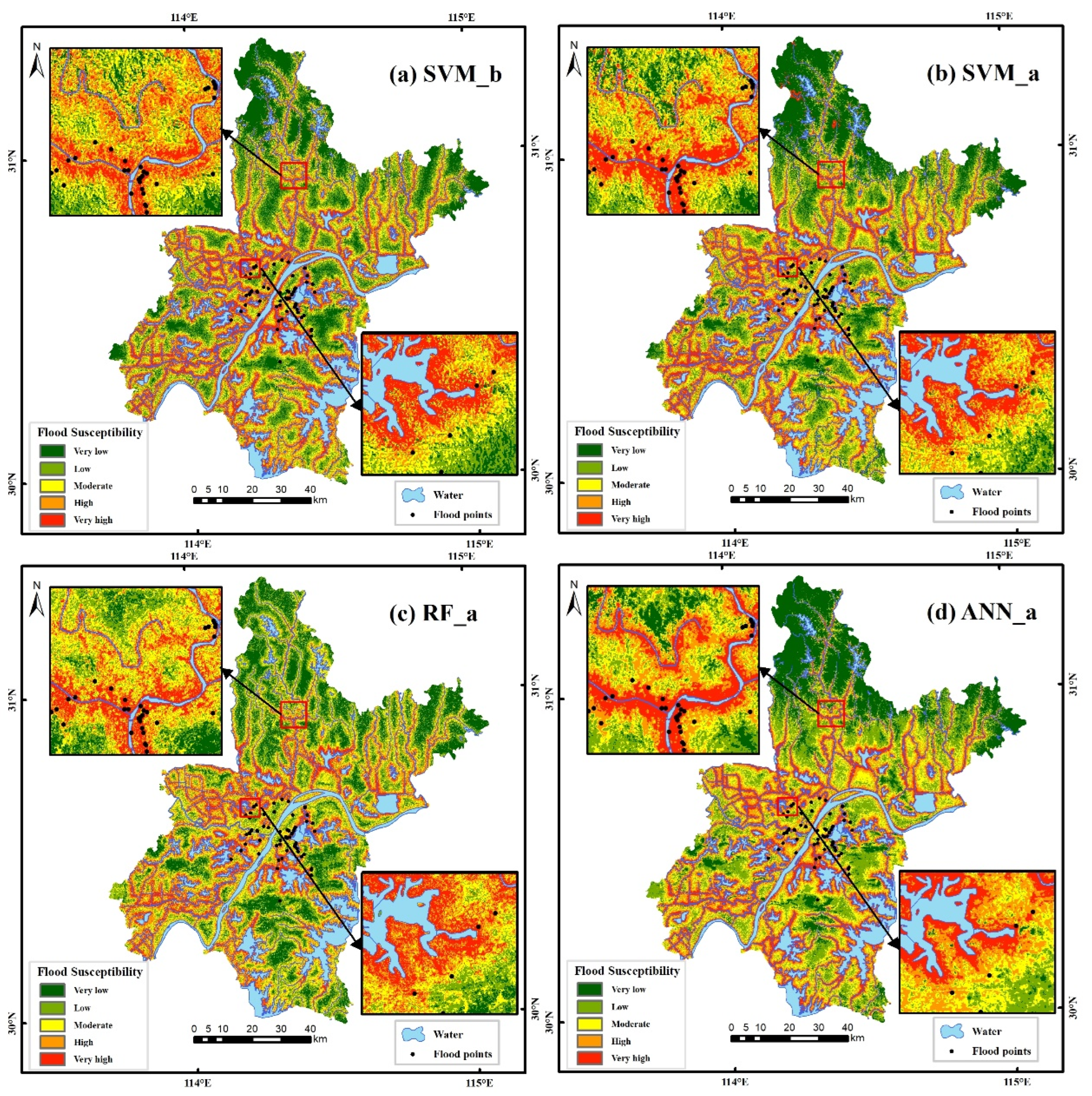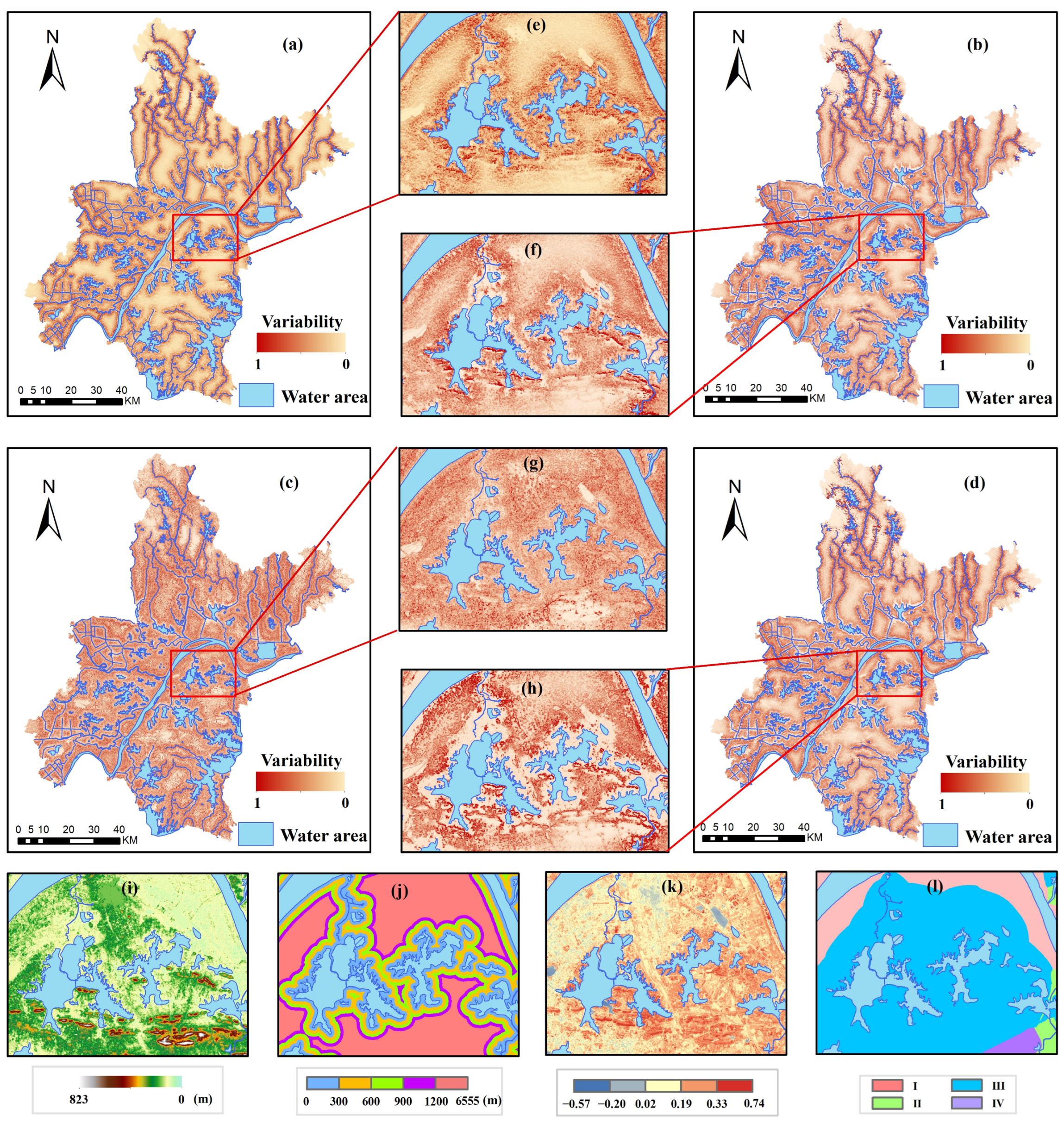Improving the Accuracy of Flood Susceptibility Prediction by Combining Machine Learning Models and the Expanded Flood Inventory Data
Abstract
1. Introduction
2. Materials and Methods
2.1. Study Area and Data
2.1.1. Study Area
2.1.2. Data
2.2. Flood Conditioning Factors
2.3. Framework and Machine Learning Models for Predicting Flood Susceptibility
2.3.1. Methods for Expanding Flood Inventory Data
2.3.2. Data Processing and Scenario Design
2.3.3. Machine Learning Models Used in This Study
2.3.4. Steps for Predicting Flood Susceptibility Using Machine Learning Models and the Expanded FID
2.4. Statistical Metrics
2.5. Analysis of Appearance Rationality of Susceptibility Mapping
3. Results
3.1. Expansion of Flood and Non-Flood Points
3.2. Multicollinearity of Flood Conditioning Factors
3.3. Training and Validation of Machine Learning Models
3.4. Performance Comparison of Machine Learning Models
3.5. Flood Susceptibility Map and Appearance Rationality Analysis in Wuhan City
4. Discussion
5. Conclusions
Author Contributions
Funding
Data Availability Statement
Acknowledgments
Conflicts of Interest
References
- Chen, W.; Hong, H.; Li, S.; Shahabi, H.; Wang, Y.; Wang, X.; Ahmad, B.B. Flood susceptibility modelling using novel hybrid approach of reduced-error pruning trees with bagging and random subspace ensembles. J. Hydrol. 2019, 575, 864–873. [Google Scholar] [CrossRef]
- Rentschler, J.; Salhab, M. People in Harm’s Way: Flood Exposure and Poverty in 189 Countries; The World Bank: Washington, DC, USA, 2020. [Google Scholar]
- Fu, S.; Lyu, H.; Wang, Z.; Hao, X.; Zhang, C. Extracting historical flood locations from news media data by the named entity recognition (NER) model to assess urban flood susceptibility. J. Hydrol. 2022, 612, 128312. [Google Scholar] [CrossRef]
- Esposito, M.; Palma, L.; Belli, A.; Sabbatini, L.; Pierleoni, P. Recent advances in internet of things solutions for early warning systems: A review. Sensors 2022, 22, 2124. [Google Scholar] [CrossRef] [PubMed]
- Giannaros, C.; Dafis, S.; Stefanidis, S.; Giannaros, T.M.; Koletsis, I.; Oikonomou, C. Hydrometeorological analysis of a flash flood event in an ungauged Mediterranean watershed under an operational forecasting and monitoring context. Meteorol. Appl. 2022, 29, e2079. [Google Scholar] [CrossRef]
- Wang, Y.; Hong, H.; Chen, W.; Li, S.; Panahi, M.; Khosravi, K.; Shirzadi, A.; Shahabi, H.; Panahi, S.; Costache, R. Flood susceptibility mapping in Dingnan County (China) using adaptive neuro-fuzzy inference system with biogeography based optimization and imperialistic competitive algorithm. J. Environ. Manag. 2019, 247, 712–729. [Google Scholar] [CrossRef]
- Al-Abadi, A.M.; Pradhan, B. In flood susceptibility assessment, is it scientifically correct to represent flood events as a point vector format and create flood inventory map? J. Hydrol. 2020, 590, 125475. [Google Scholar] [CrossRef]
- Ekmekcioğlu, Ö.; Koc, K.; Özger, M.; Işık, Z. Exploring the additional value of class imbalance distributions on interpretable flash flood susceptibility prediction in the Black Warrior River basin, Alabama, United States. J. Hydrol. 2022, 610, 127877. [Google Scholar] [CrossRef]
- Fang, Z.; Wang, Y.; Peng, L.; Hong, H. Predicting flood susceptibility using LSTM neural networks. J. Hydrol. 2021, 594, 125734. [Google Scholar] [CrossRef]
- Wang, Y.; Fang, Z.; Hong, H.; Peng, L. Flood susceptibility mapping using convolutional neural network frameworks. J. Hydrol. 2020, 582, 124482. [Google Scholar] [CrossRef]
- Merz, B.; Thieken, A.H.; Gocht, M. Flood risk mapping at the local scale: Concepts and challenges. Adv. Nat. Technol. Hazards Res. 2007, 25, 231–251. [Google Scholar] [CrossRef]
- Tehrany, M.S.; Pradhan, B.; Mansor, S.; Ahmad, N. Flood susceptibility assessment using GIS-based support vector machine model with different kernel types. Catena 2015, 125, 91–101. [Google Scholar] [CrossRef]
- Zhao, G.; Pang, B.; Xu, Z.; Peng, D.; Zuo, D. Urban flood susceptibility assessment based on convolutional neural networks. J. Hydrol. 2020, 590, 125235. [Google Scholar] [CrossRef]
- Li, Y.; Hong, H. Modelling flood susceptibility based on deep learning coupling with ensemble learning models. J. Environ. Manag. 2023, 325, 116450. [Google Scholar] [CrossRef]
- Saha, T.K.; Pal, S.; Talukdar, S.; Debanshi, S.; Khatun, R.; Singha, P.; Mandal, I. How far spatial resolution affects the ensemble machine learning based flood susceptibility prediction in data sparse region. J. Environ. Manag. 2021, 297, 113344. [Google Scholar] [CrossRef] [PubMed]
- Adhikari, P.; Hong, Y.; Douglas, K.R.; Kirschbaum, D.B.; Gourley, J.; Adler, R.; Brakenridge, G.R. A digitized global flood inventory (1998–2008): Compilation and preliminary results. Nat. Hazards 2010, 55, 405–422. [Google Scholar] [CrossRef]
- Hong, H.; Panahi, M.; Shirzadi, A.; Ma, T.; Liu, J.; Zhu, A.X.; Chen, W.; Kougias, I.; Kazakis, N. Flood susceptibility assessment in Hengfeng area coupling adaptive neuro-fuzzy inference system with genetic algorithm and differential evolution. Sci. Total Environ. 2018, 621, 1124–1141. [Google Scholar] [CrossRef]
- Shahabi, H.; Shirzadi, A.; Ghaderi, K.; Omidvar, E.; Al-Ansari, N.; Clague, J.J.; Geertsema, M.; Khosravi, K.; Amini, A.; Bahrami, S.; et al. Flood detection and susceptibility mapping using Sentinel-1 remote sensing data and a machine learning approach: Hybrid intelligence of bagging ensemble based on K-Nearest Neighbor classifier. Remote Sens. 2020, 12, 266. [Google Scholar] [CrossRef]
- Zhang, X.; Chan, N.W.; Pan, B.; Ge, X.; Yang, H. Mapping flood by the object-based method using backscattering coefficient and interference coherence of Sentinel-1 time series. Sci. Total Environ. 2021, 794, 148388. [Google Scholar] [CrossRef]
- Huth, J.; Gessner, U.; Klein, I.; Yesou, H.; Lai, X.; Oppelt, N.; Kuenzer, C. Analyzing water dynamics based on sentinel-1 time series-a study for dongting lakewetlands in China. Remote Sens. 2020, 12, 1761. [Google Scholar] [CrossRef]
- Uddin, K.; Matin, M.A.; Meyer, F.J. Operational flood mapping using multi-temporal Sentinel-1 SAR images: A case study from Bangladesh. Remote Sens. 2019, 11, 1581. [Google Scholar] [CrossRef]
- Zeng, Z.; Gan, Y.; Kettner, A.J.; Yang, Q.; Zeng, C.; Brakenridge, G.R.; Hong, Y. Towards high resolution flood monitoring: An integrated methodology using passive microwave brightness temperatures and Sentinel synthetic aperture radar imagery. J. Hydrol. 2020, 582, 124377. [Google Scholar] [CrossRef]
- Yuan, X.; Zhang, X.c.; Wang, X.g.; Zhang, Y. Flood disaster monitoring based on Sentinel-1 data: A case study of Sihu Basin and Huaibei Plain, China. Water Sci. Eng. 2021, 14, 87–96. [Google Scholar] [CrossRef]
- McCormack, T.; Campanyà, J.; Naughton, O. A methodology for mapping annual flood extent using multi-temporal Sentinel-1 imagery. Remote Sens. Environ. 2022, 282, 113273. [Google Scholar] [CrossRef]
- Sachdeva, S.; Kumar, B. Flood susceptibility mapping using extremely randomized trees for Assam 2020 floods. Ecol. Inform. 2022, 67, 101498. [Google Scholar] [CrossRef]
- Bekele, T.W.; Haile, A.T.; Trigg, M.A.; Walsh, C.L. Evaluating a new method of remote sensing for flood mapping in the urban and peri-urban areas: Applied to Addis Ababa and the Akaki catchment in Ethiopia. Nat. Hazards Res. 2022, 2, 97–110. [Google Scholar] [CrossRef]
- Mehravar, S.; Razavi-Termeh, S.V.; Moghimi, A.; Ranjgar, B.; Foroughnia, F.; Amani, M. Flood susceptibility mapping using multi-temporal SAR imagery and novel integration of nature-inspired algorithms into support vector regression. J. Hydrol. 2023, 617, 129100. [Google Scholar] [CrossRef]
- Wang, X.; Xia, J.; Zhou, M.; Deng, S.; Li, Q. Assessment of the joint impact of rainfall and river water level on urban flooding in Wuhan City, China. J. Hydrol. 2022, 613, 128419. [Google Scholar] [CrossRef]
- Liu, X.; Yang, S.; Ye, T.; An, R.; Chen, C. A new approach to estimating flood-affected populations by combining mobility patterns with multi-source data: A case study of Wuhan, China. Int. J. Disaster Risk Reduct. 2021, 55, 102106. [Google Scholar] [CrossRef]
- Huang, F.; Cao, Z.; Jiang, S.H.; Zhou, C.; Huang, J.; Guo, Z. Landslide susceptibility prediction based on a semi-supervised multiple-layer perceptron model. Landslides 2020, 17, 2919–2930. [Google Scholar] [CrossRef]
- DeVries, B.; Huang, C.; Armston, J.; Huang, W.; Jones, J.W.; Lang, M.W. Rapid and robust monitoring of flood events using Sentinel-1 and Landsat data on the Google Earth Engine. Remote Sens. Environ. 2020, 240, 111664. [Google Scholar] [CrossRef]
- Tavus, B.; Kocaman, S.; Gokceoglu, C. Flood damage assessment with Sentinel-1 and Sentinel-2 data after Sardoba dam break with GLCM features and Random Forest method. Sci. Total Environ. 2022, 816, 151585. [Google Scholar] [CrossRef]
- Xiang, J.; Guo, S.; Shi, X.; Yu, D.; Wei, G.; Wen, N.; Chen, C.; Dai, K. Revealing the Morphological Evolution of Krakatau Volcano by Integrating SAR and Optical Remote Sensing Images. Remote Sens. 2022, 14, 1399. [Google Scholar] [CrossRef]
- Chapi, K.; Singh, V.P.; Shirzadi, A.; Shahabi, H.; Bui, D.T.; Pham, B.T.; Khosravi, K. A novel hybrid artificial intelligence approach for flood susceptibility assessment. Environ. Model. Softw. 2017, 95, 229–245. [Google Scholar] [CrossRef]
- Mousavi, S.M.; Ataie-Ashtiani, B.; Hosseini, S.M. Comparison of statistical and MCDM approaches for flood susceptibility mapping in northern Iran. J. Hydrol. 2022, 612, 128072. [Google Scholar] [CrossRef]
- Tehrany, M.S.; Pradhan, B.; Jebur, M.N. Flood susceptibility mapping using a novel ensemble weights-of-evidence and support vector machine models in GIS. J. Hydrol. 2014, 512, 332–343. [Google Scholar] [CrossRef]
- Liu, Y.; Wang, Z.; Yang, X.; Zhang, Y.; Yang, F.; Liu, B.; Cai, P. Satellite-based monitoring and statistics for raft and cage aquaculture in China’s offshore waters. Int. J. Appl. Earth Obs. Geoinf. 2020, 91, 102118. [Google Scholar] [CrossRef]
- Tien Bui, D.; Hoang, N.D.; Pham, T.D.; Ngo, P.T.T.; Hoa, P.V.; Minh, N.Q.; Tran, X.T.; Samui, P. A new intelligence approach based on GIS-based Multivariate Adaptive Regression Splines and metaheuristic optimization for predicting flash flood susceptible areas at high-frequency tropical typhoon area. J. Hydrol. 2019, 575, 314–326. [Google Scholar] [CrossRef]
- Cui, H.; Huang, D.; Fang, Y.; Liu, L.; Huang, C. Webshell detection based on random forest-gradient boosting decision tree algorithm. In Proceedings of the 2018 IEEE 3rd International Conference on Data Science in Cyberspace, DSC 2018, Guangzhou, China, 18–21 June 2018. [Google Scholar] [CrossRef]
- Rong, G.; Alu, S.; Li, K.; Su, Y.; Zhang, J.; Zhang, Y.; Li, T. Rainfall induced landslide susceptibility mapping based on bayesian optimized random forest and gradient boosting decision tree models—A case study of shuicheng county, china. Water 2020, 12, 3066. [Google Scholar] [CrossRef]
- Wu, X.; Kumar, V.; Ross, Q.J.; Ghosh, J.; Yang, Q.; Motoda, H.; McLachlan, G.J.; Ng, A.; Liu, B.; Yu, P.S.; et al. Top 10 algorithms in data mining. Knowl. Inf. Syst. 2008, 14, 1–37. [Google Scholar] [CrossRef]
- Choubin, B.; Moradi, E.; Golshan, M.; Adamowski, J.; Sajedi-Hosseini, F.; Mosavi, A. An ensemble prediction of flood susceptibility using multivariate discriminant analysis, classification and regression trees, and support vector machines. Sci. Total Environ. 2019, 651, 2087–2096. [Google Scholar] [CrossRef]
- Towfiqul Islam, A.R.M.; Talukdar, S.; Mahato, S.; Kundu, S.; Eibek, K.U.; Pham, Q.B.; Kuriqi, A.; Linh, N.T.T. Flood susceptibility modelling using advanced ensemble machine learning models. Geosci. Front. 2021, 12, 101075. [Google Scholar] [CrossRef]
- Bui, Q.T.; Nguyen, Q.H.; Nguyen, X.L.; Pham, V.D.; Nguyen, H.D.; Pham, V.M. Verification of novel integrations of swarm intelligence algorithms into deep learning neural network for flood susceptibility mapping. J. Hydrol. 2020, 581, 124379. [Google Scholar] [CrossRef]
- Goetz, J.; Brenning, A.; Petschko, H.; Leopold, P. Evaluating machine learning and statistical prediction techniques for landslide susceptibility modeling. Comput. Geosci. 2015, 81, 1–11. [Google Scholar] [CrossRef]
- Hasanuzzaman, M.; Islam, A.; Bera, B.; Shit, P.K. A comparison of performance measures of three machine learning algorithms for flood susceptibility mapping of river Silabati (tropical river, India). Phys. Chem. Earth 2022, 127, 103198. [Google Scholar] [CrossRef]
- Steger, S.; Brenning, A.; Bell, R.; Petschko, H.; Glade, T. Exploring discrepancies between quantitative validation results and the geomorphic plausibility of statistical landslide susceptibility maps. Geomorphology 2016, 262, 8–23. [Google Scholar] [CrossRef]
- Dormann, C.F.; Elith, J.; Bacher, S.; Buchmann, C.; Carl, G.; Carré, G.; Marquéz, J.R.G.; Gruber, B.; Lafourcade, B.; Leitão, P.J. Collinearity: A review of methods to deal with it and a simulation study evaluating their performance. Ecography 2013, 36, 27–46. [Google Scholar] [CrossRef]
- James, G.; Witten, D.; Hastie, T.; Tibshirani, R. An Introduction to Statistical Learning; Springer: Berlin/Heidelberg, Germany, 2013; Volume 112. [Google Scholar]
- Zhao, G.; Pang, B.; Xu, Z.; Cui, L.; Wang, J.; Zuo, D.; Peng, D. Improving urban flood susceptibility mapping using transfer learning. J. Hydrol. 2021, 602, 126777. [Google Scholar] [CrossRef]
- McCartney, M.; Haeringer, M.; Polifke, W. Comparison of Machine Learning Algorithms in the Interpolation and Extrapolation of Flame Describing Functions. J. Eng. Gas Turbines Power 2020, 142, 061009. [Google Scholar] [CrossRef]
- Chini, M.; Pelich, R.; Pulvirenti, L.; Pierdicca, N.; Hostache, R.; Matgen, P. Sentinel-1 InSAR coherence to detect floodwater in urban areas: Houston and hurricane harvey as a test case. Remote Sens. 2019, 11, 107. [Google Scholar] [CrossRef]
- Mason, D.C.; Dance, S.L.; Cloke, H.L. Floodwater detection in urban areas using Sentinel-1 and WorldDEM data. J. Appl. Remote Sens. 2021, 15, 032003. [Google Scholar] [CrossRef]
- Otsu, N. A threshold selection method from gray-level histograms. IEEE Trans. Syst. Man Cybern. 1979, 9, 62–66. [Google Scholar] [CrossRef]
- Huang, M.; Yu, W.; Zhu, D. An improved image segmentation algorithm based on the Otsu method. In Proceedings of the 2012 13th ACIS International Conference on Software Engineering, Artificial Intelligence, Networking and Parallel/Distributed Computing, Kyoto, Japan, 8–10 August 2012; pp. 135–139. [Google Scholar]
- Lee, S.U.; Chung, S.Y.; Park, R.H. A comparative performance study of several global thresholding techniques for segmentation. Comput. Vis. Graph. Image Process. 1990, 52, 171–190. [Google Scholar] [CrossRef]
- Du, W.; Gong, Y.; Chen, N.C. PSO-WELLSVM: An integrated method and its application in urban waterlogging susceptibility assessment in the central Wuhan, China. Comput. Geosci. 2022, 161, 105079. [Google Scholar] [CrossRef]
- Zhao, G.; Pang, B.; Xu, Z.; Peng, D.; Xu, L. Assessment of urban flood susceptibility using semi-supervised machine learning model. Sci. Total Environ. 2019, 659, 940–949. [Google Scholar] [CrossRef] [PubMed]
- Pradhan, B.; Lee, S.; Dikshit, A.; Kim, H. Spatial flood susceptibility mapping using an explainable artificial intelligence (XAI) model. Geosci. Front. 2023, 14, 101625. [Google Scholar] [CrossRef]








| Flood Conditioning Factor | Data Source | Meaning | Resolution | Equation | Variable Description |
|---|---|---|---|---|---|
| Elevation | GDEM V2 | The distance from a point along the vertical line to the absolute base plane | 30 M | Extraction based on DEM | - |
| Slope | GDEM V2 | Degree of surface steepness | 30 M | Extraction based on DEM | - |
| Aspect | GDEM V2 | Direction of projection of the slope normal on the horizontal plane | 30 M | Extraction based on DEM | - |
| Curvature | GDEM V2 | The degree of curvature of a curve at a point | 30 M | Extraction based on DEM | - |
| NDVI | Landsat-8 OLI_TIRS | Normalized difference vegetation index | 30 M | where NIR and R refer to the top of the atmosphere reflectance of the near-infrared (0.86 µm) and red band, respectively. | |
| NDBI | Landsat-8 OLI_TIRS | Normalized differences built-up index | 30 M | where SWIR and NIR are the top of the atmosphere reflectance of the shortwave infrared (2.2 µm) and near infrared band, respectively. | |
| TWI | GDEM V2 | Topographic wetness index | 30 M | where AS is the specific catchment area in units of (m2 m−1) and β is a slope in radians [36]. | |
| SPI | GDEM V2 | Stream power index | 30 M | ||
| Soil type | National 1:6 million soil-type dataset | Soil classification | 1:600 million | - | - |
| Land use | FROM-GLC 10 2017v1 | Land use classification | 10 M | - | - |
| Distance to water | 1:1 million basic geographic vector map data | The Euclidean distance to the closest water area | 1:100 million | - | - |
| Distance type | 1:1 million basic geographic vector map data | Classification of water body types nearest to pixels based on the Euclidean distance | 1:100 million | - | - |
| Land Use | Soil Type | Distance Type | |||
|---|---|---|---|---|---|
| Code | Description | Code | Description | Code | Description |
| 0 | - | A | Swampy Soil | I | Yangtze and Han Rivers |
| 1 | Crop | B | Lakes and water | II | Rivers |
| 2 | Forest | C | Dark yellow–brown loam | III | Lakes |
| 3 | Grass | D | Alluvial soils | IV | Reservoirs |
| 4 | Shrub | E | Tidal soils | - | - |
| 5 | Wetland | F | Rice soils | - | - |
| 6 | Water | G | Yellow–brown loam | - | - |
| 7 | Tundra | H | Yellow–brown loam | - | - |
| 8 | Impervious | I | Yellow–red loam | - | - |
| 9 | Bare land | J | Yellow–brown loam | - | - |
| 10 | Snow/ice | K | Percolating rice | - | - |
| 11 | Cloud | L | Trapped rice | - | - |
| - | - | M | Red loam | - | - |
| - | - | N | Grey tide soil | - | - |
| - | - | O | Red loamy soils | - | - |
| - | - | P | Brown–red loam | - | - |
| - | - | Q | De-submerged rice | - | - |
| - | - | R | Urban area | - | - |
| - | - | S | River and stream | - | - |
| - | - | T | Rinsed rice | - | - |
| Factors | VIF | Factors | VIF |
|---|---|---|---|
| Elevation | 3.81 | Slope | 4.58 |
| NDVI | 5.25 | Curvature | 1.12 |
| SPI | 1.43 | NDBI | 2.85 |
| TWI | 5.82 | Distance to water | 2.91 |
| LU | 2.84 | Distance type | 11.83 |
| Aspect | 3.53 | Soil type | 9.50 |
| Model | Hyperparameters of without Considering Data Expansion | Hyperparameters of with Considering Data Expansion |
|---|---|---|
| RF | n_estimators = 15 | n_estimators = 25 |
| GBDT | n_estimators = 100, loss = ‘deviance’, learning_rate = 0.1 | n_estimators = 100, loss = ‘deviance’, learning_rate = 0.1 |
| ANN | batch_size = 4, epoch = 60, activation function: ReLU | batch_size = 4, epoch = 80, activation function: ReLU |
| KNN | n_jobs = −1, n_neighbors = 7 | n_jobs = −1, n_neighbors = 15 |
| SVM | kernel = ‘rbf’, C = 195, gamma = 1.0, probability = True | kernel = ‘rbf’, C = 198, gamma = 1.0, probability = True |
| Model in Scenario 1, without Considering Expanded FID | AUC Value under Cross-Validation | AUC Value under Spatial Cross-Validation | Model in Scenario 2, with Considering Expanded FID | AUC Value under Cross-Validation | AUC Value under Spatial Cross-Validation |
|---|---|---|---|---|---|
| RF | 0.89 | 0.97 | RF | 0.90 | 0.95 |
| GBDT | 0.90 | 0.98 | GBDT | 0.92 | 0.95 |
| KNN | 0.83 | 0.82 | KNN | 0.89 | 0.81 |
| SVM | 0.87 | 0.82 | SVM | 0.92 | 0.86 |
| ANN | 0.97 | 0.92 | ANN | 0.94 | 0.89 |
| Scenario | Model | Kappa | AUC | Precision | Recall | F1-Score | Improvement of AUC (%) |
|---|---|---|---|---|---|---|---|
| Models in Scenario 1 | RF | 0.25 | 0.80 | 0.67 | 0.62 | 0.59 | - |
| GBDT | 0.30 | 0.76 | 0.64 | 0.6 | 0.58 | - | |
| KNN | 0.47 | 0.77 | 0.75 | 0.73 | 0.72 | - | |
| SVM | 0.57 | 0.88 | 0.75 | 0.74 | 0.73 | - | |
| ANN | 0.60 | 0.83 | 0.81 | 0.79 | 0.8 | - | |
| Models in Scenario 2 | RF | 0.72 | 0.93 | 0.86 | 0.86 | 0.86 | 16.25 |
| GBDT | 0.70 | 0.91 | 0.85 | 0.85 | 0.85 | 19.74 | |
| KNN | 0.53 | 0.86 | 0.83 | 0.83 | 0.83 | 11.69 | |
| SVM | 0.70 | 0.89 | 0.77 | 0.76 | 0.76 | 1.14 | |
| ANN | 0.72 | 0.91 | 0.83 | 0.91 | 0.86 | 9.64 |
Disclaimer/Publisher’s Note: The statements, opinions and data contained in all publications are solely those of the individual author(s) and contributor(s) and not of MDPI and/or the editor(s). MDPI and/or the editor(s) disclaim responsibility for any injury to people or property resulting from any ideas, methods, instructions or products referred to in the content. |
© 2023 by the authors. Licensee MDPI, Basel, Switzerland. This article is an open access article distributed under the terms and conditions of the Creative Commons Attribution (CC BY) license (https://creativecommons.org/licenses/by/4.0/).
Share and Cite
Yu, H.; Luo, Z.; Wang, L.; Ding, X.; Wang, S. Improving the Accuracy of Flood Susceptibility Prediction by Combining Machine Learning Models and the Expanded Flood Inventory Data. Remote Sens. 2023, 15, 3601. https://doi.org/10.3390/rs15143601
Yu H, Luo Z, Wang L, Ding X, Wang S. Improving the Accuracy of Flood Susceptibility Prediction by Combining Machine Learning Models and the Expanded Flood Inventory Data. Remote Sensing. 2023; 15(14):3601. https://doi.org/10.3390/rs15143601
Chicago/Turabian StyleYu, Han, Zengliang Luo, Lunche Wang, Xiangyi Ding, and Shaoqiang Wang. 2023. "Improving the Accuracy of Flood Susceptibility Prediction by Combining Machine Learning Models and the Expanded Flood Inventory Data" Remote Sensing 15, no. 14: 3601. https://doi.org/10.3390/rs15143601
APA StyleYu, H., Luo, Z., Wang, L., Ding, X., & Wang, S. (2023). Improving the Accuracy of Flood Susceptibility Prediction by Combining Machine Learning Models and the Expanded Flood Inventory Data. Remote Sensing, 15(14), 3601. https://doi.org/10.3390/rs15143601









